1996 CADILLAC ELDORADO coolant level
[x] Cancel search: coolant levelPage 130 of 354
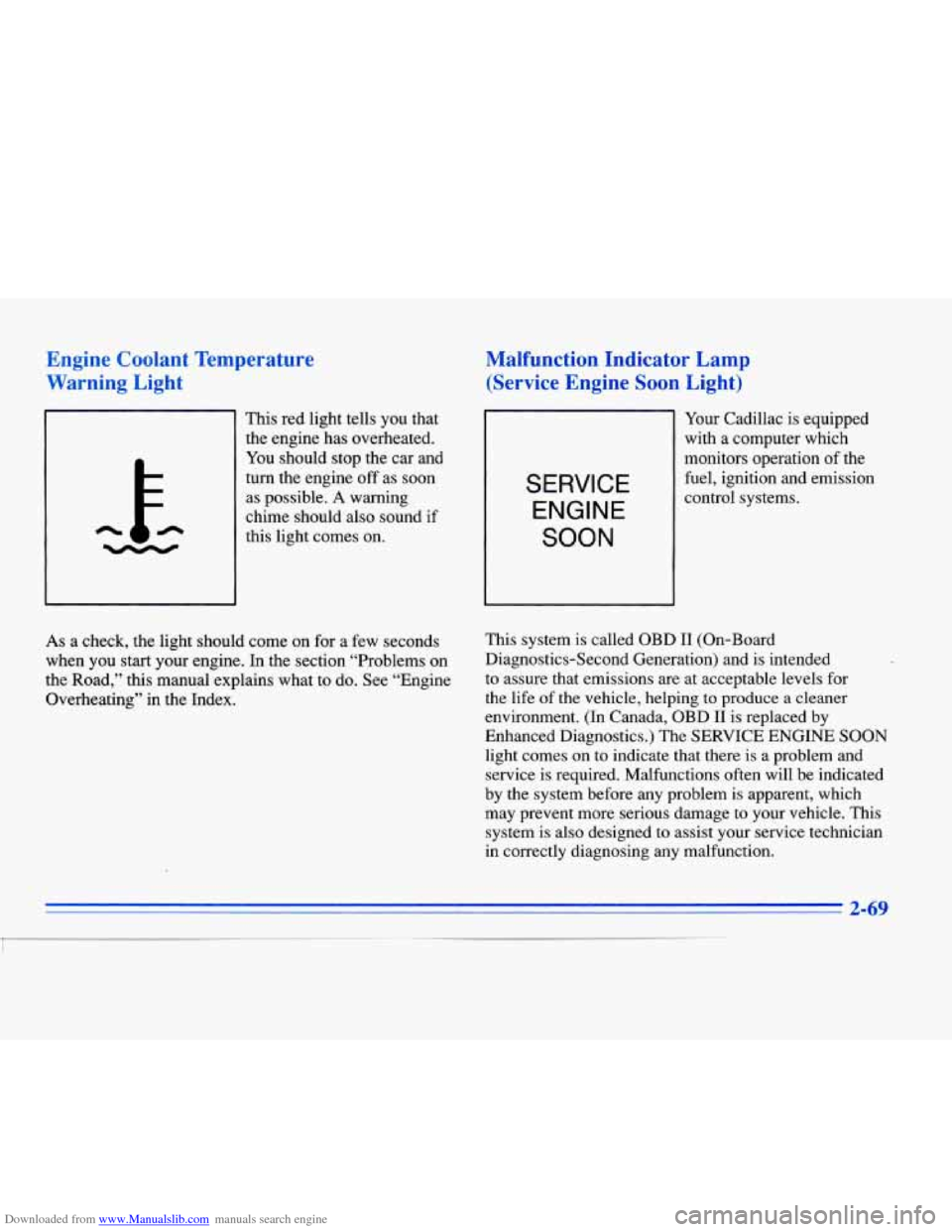
Downloaded from www.Manualslib.com manuals search engine Engine Coolant Temperature
Warning Light Malfunction Indicator Lamp
(Service Engine Soon Light)
This red light tells you that
the engine has overheated.
You should stop the car and
turn the engine
off as soon
as possible.
A warning
chime should also sound if
this light comes on. SERVICE
ENGINE
SOON
Your Cadillac is equipped
i with a computer which
monitors operation
of the
l fuel, ignition and emission
1 control systems.
As a check, the light should come on for a few seconds
when you start your engine.
In the section “Problems on
the Road,” this manual explains what to
do. See “Engine
Overheating”
in the Index. This
system is called
OBD I1 (On-Board
Diagnostics-Second Generation) and is intended
to assure that emissions are at acceptable levels for
the life of the vehicle, helping
to produce a cleaner
environment. (In Canada, OBD
I1 is replaced by
Enhanced Diagnostics.) The SERVICE ENGINE
SOON
light comes on to indicate that there is a problem and
service is required. Malfunctions often will be indicated
by the system before any problem is apparent, which
may prevent more serious damage to your vehicle. This
system is also designed to assist your service technician
in correctly diagnosing any malfunction.
2-69
Page 141 of 354
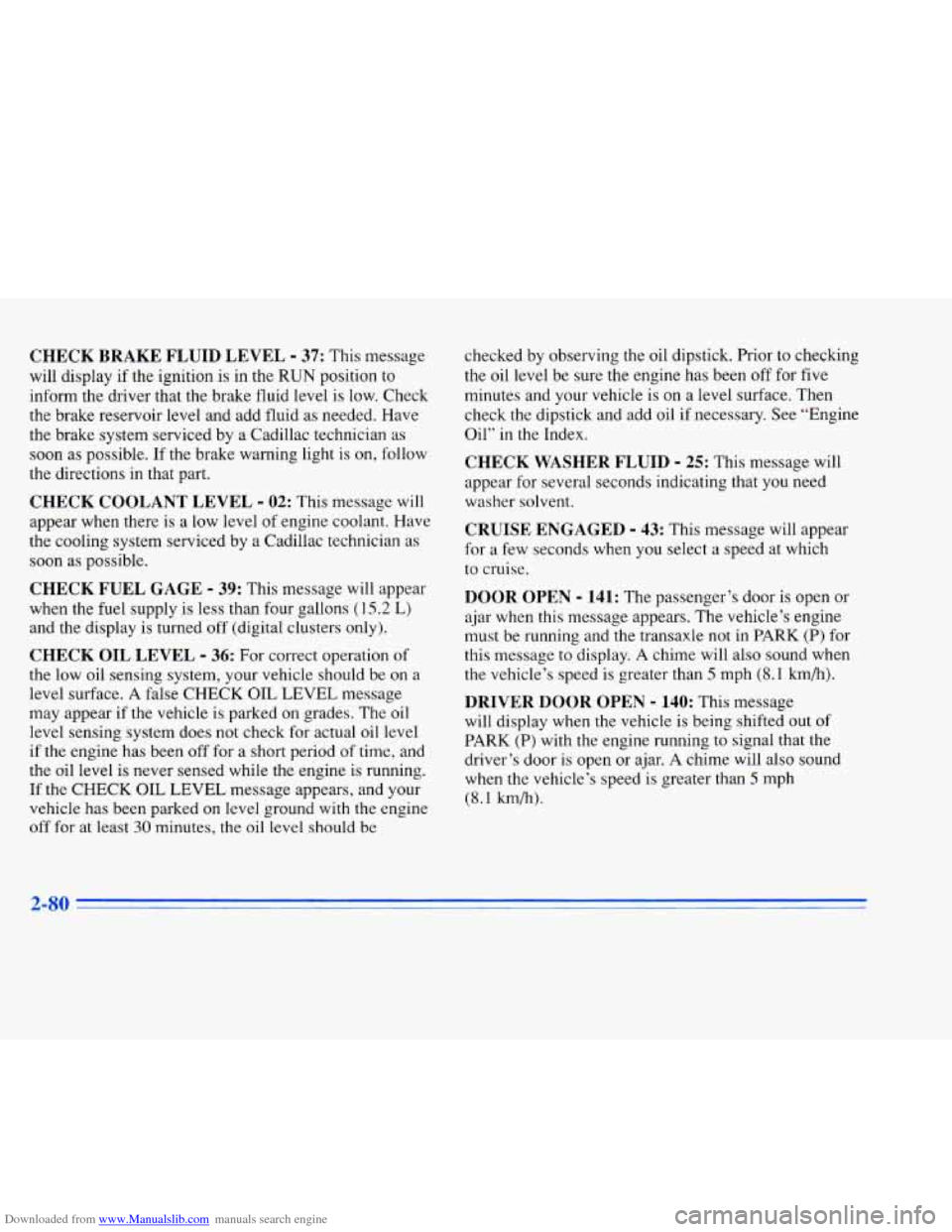
Downloaded from www.Manualslib.com manuals search engine CHECK BRAKE FLUID LEVEL - 37: This message
will display if the ignition
is in the RUN position to
inform the driver that the brake fluid level is low. Check
the brake reservoir level and add fluid as needed. Have
the brake system serviced by a Cadillac technician as
soon as possible. If the brake warning light is on, follow
the directions in that part.
CHECK COOLANT LEVEL - 02: This message will
appear when there is a low level of engine coolant. Have
the cooling system serviced by a Cadillac technician as
soon as possible.
CHECK FUEL GAGE - 39: This message will appear
when the
fuel supply is less than four gallons (I 5.2 L)
and the display is turned off (digital clusters only).
CHECK OIL LEVEL - 36: For correct operation of
the low oil sensing system, your vehicle should be on a
level surface.
A false CHECK OIL LEVEL message
may appear
if the vehicle is parked on grades. The oil
level sensing system does not check for actual oil level
if the engine has been off for a short period of time, and
the oil level is never sensed while the engine is running.
If the CHECK
OIL LEVEL message appears, and your
vehicle has been parked
on level ground with the engine
off for at least
30 minutes, the oil level should be checked
by observing the oil dipstick. Prior to checking
the oil level be sure
the engine has been off for five
minutes and your vehicle
is on a level surface. Then
check the dipstick and add oil if necessary. See “Engine
Oil”
in the Index.
CHECK WASHER FLUID - 25: This message will
appear for several seconds indicating that you need
washer solvent.
CRUISE ENGAGED - 43: This message will appear
for a few seconds when you select a speed at which
to cruise.
DOOR OPEN - 141: The passenger’s door is open or
ajar when this message appears. The vehicle’s engine
must be running and the transaxle
not in PARK (P) for
this message to display.
A chime will also sound when
the vehicle’s speed is greater than
5 mph (8.1 km/h).
DRIVER DOOR OPEN - 140: This message
will display when the vehicle is being shifted out of
PARK (P) with the engine running to signal that the
driver’s door
is open or ajar. A chime will also sound
when the vehicle’s speed is greater than 5 mph
(8.1 km/h).
2-80
Page 142 of 354

Downloaded from www.Manualslib.com manuals search engine ENGINE COOLANT HOT-IDLE ENGINE - 44:
This message will appear when the engine coolant
temperature is over
248 OF (126°C). To avoid added
strain on a hot engine, turn off the climate control
system. Stop and allow your vehicle to idle until it cools
down or
the message is removed. If it does not cool
down, turn off the engine and have it serviced before
driving it again. Severe engine damage can result from
an overheated engine. See “Engine Overheating” in
the Index.
FUEL LEVEL VERY LOW - 11: This message serves
as a warning that the fuel level in the tank is critically
low. Stop for fuel immediately.
MONITORED SYSTEMS OK - 1: This message only
appears in the “recall” mode by pressing the RESET
button. It lets you know that no other messages are
stored or currently active.
PASS KEY NOT PROGRAMMED - 31: This
warning message displays when the PASS-Key pellet
information has not been programmed into your vehicle.
See your Cadillac dealership for service.
PCM FAULT - 110: The circuit in the Powertrain
Control Module (PCM) has shorted or is loose when this
message appears. Have your Cadillac serviced by your
dealership at once.
REDUCED ENGINE POWER - 41: This message
informs the driver that due to wheel slippage your
vehicle is reducing engine power to compensate for the
loss of traction. Accelerating too fast causing the tires to
spin is an example of when this message would display.
REMOVE KEY - 70: This message will appear when
the Personalized Automotive Security System
(PASS-Key
11) is unable to read the pellet on the
ignition key or an improper key pellet has been inserted.
Wait for the DIC to display STARTING DISABLED
DUE TO THEFT SYSTEM REMOVE IGNITION
KEY. The instrument panel cluster will then run a timer
and change the messages to WAIT
3 MINUTES, WAIT
2 MINUTES, WAIT 1 MINUTE and then START CAR.
When the REMOVE KEY message is displayed, remove
the ignition key. Check the ignition key for damage.
If it
is damaged, it may need to be replaced. If you see no
damage, clean the pellet contacts with a soft cloth or
2-81
Page 154 of 354
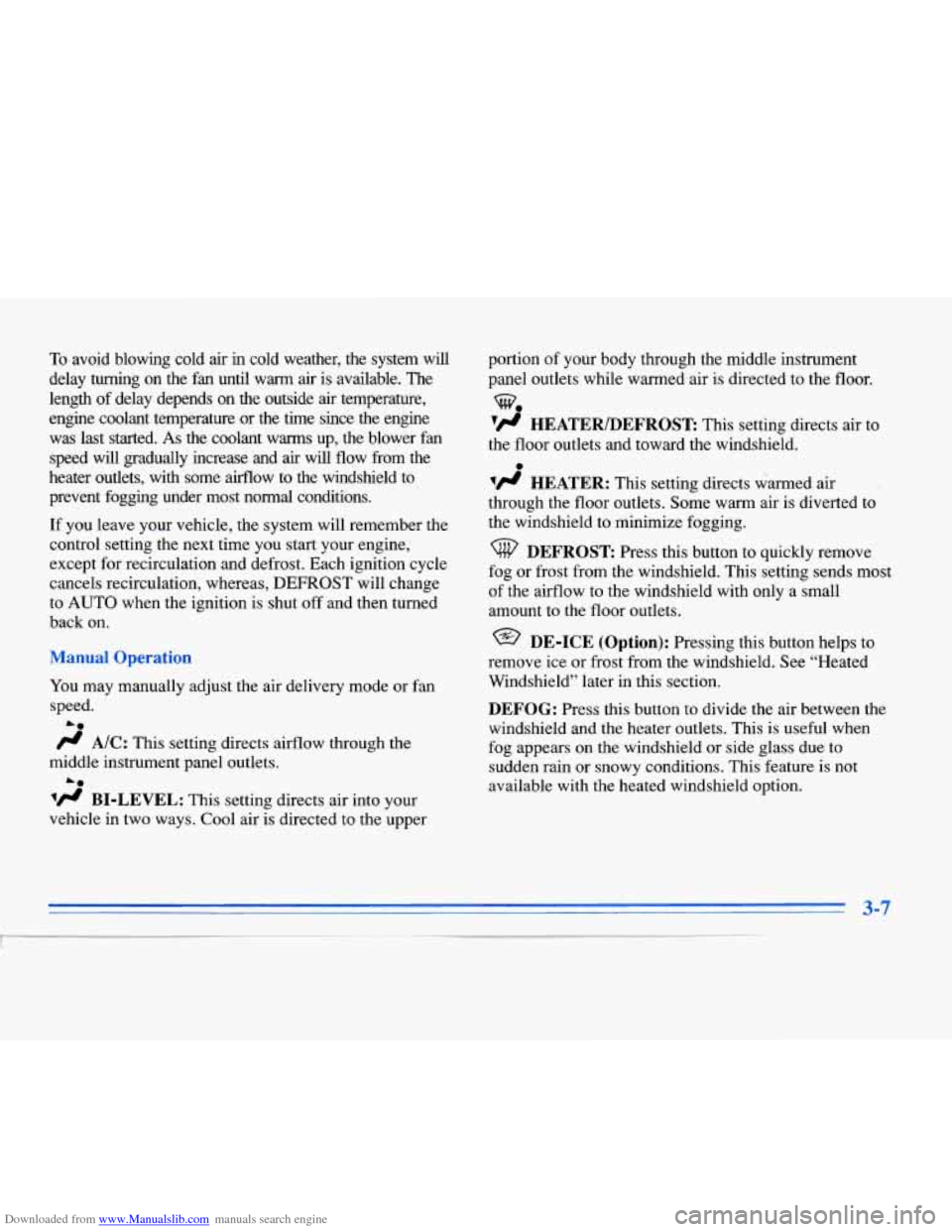
Downloaded from www.Manualslib.com manuals search engine To avoid blowing cold air in cold weather, the system will
delay
turning on the fan until warm air is available. The
length
of delay depends on the outside air temperature,
engine coolant temperature or the time since the engine
was last started. As the coolant warms up, the blower fan
speed will gradually increase and air will flow from the
heater outlets, with some airflow to the windshield to
prevent fogging under most normal conditions.
If you leave your vehicle, the system will remember the
control setting the next time you start your engine,
except for recirculation and defrost. Each ignition cycle
cancels recirculation, whereas, DEmROST will change
to
AUTO when the ignition is shut off and then turned
back on.
You may manually adjust the air delivery mode or fan
speed.
/.I A/C: This setting directs airflow through the
A@
middle instrument panel outlets.
A@
BI-LEVEL: This setting directs air into your
vehicle in two ways. Cool air is directed to the upper portion
of your body through the middle instrument
panel outlets while warmed air is directed to the floor.
‘fl HEATER/DEFROST: This setting directs air to
the floor outlets and toward the windshield.
w.
0
vH HEATER: This setting directs warmed air
through the floor outlets. Some warm air is diverted to
the windshield to minimize fogging.
DEFROST Press this button to quickly remove
fog or frost from the windshield. This setting sends most
of the airflow to the windshield with only a small
amount to the floor outlets.
@ DE-ICE (Option): Pressing this button helps to
remove ice or frost from the windshield. See “Heated
Windshield” later in this section.
DEFOG: Press this button to divide the air between the
windshield and the heater outlets. This is useful when
fog appears on the windshield or side glass due to
sudden rain or snowy conditions. This feature is not
available with the heated windshield option.
Page 240 of 354
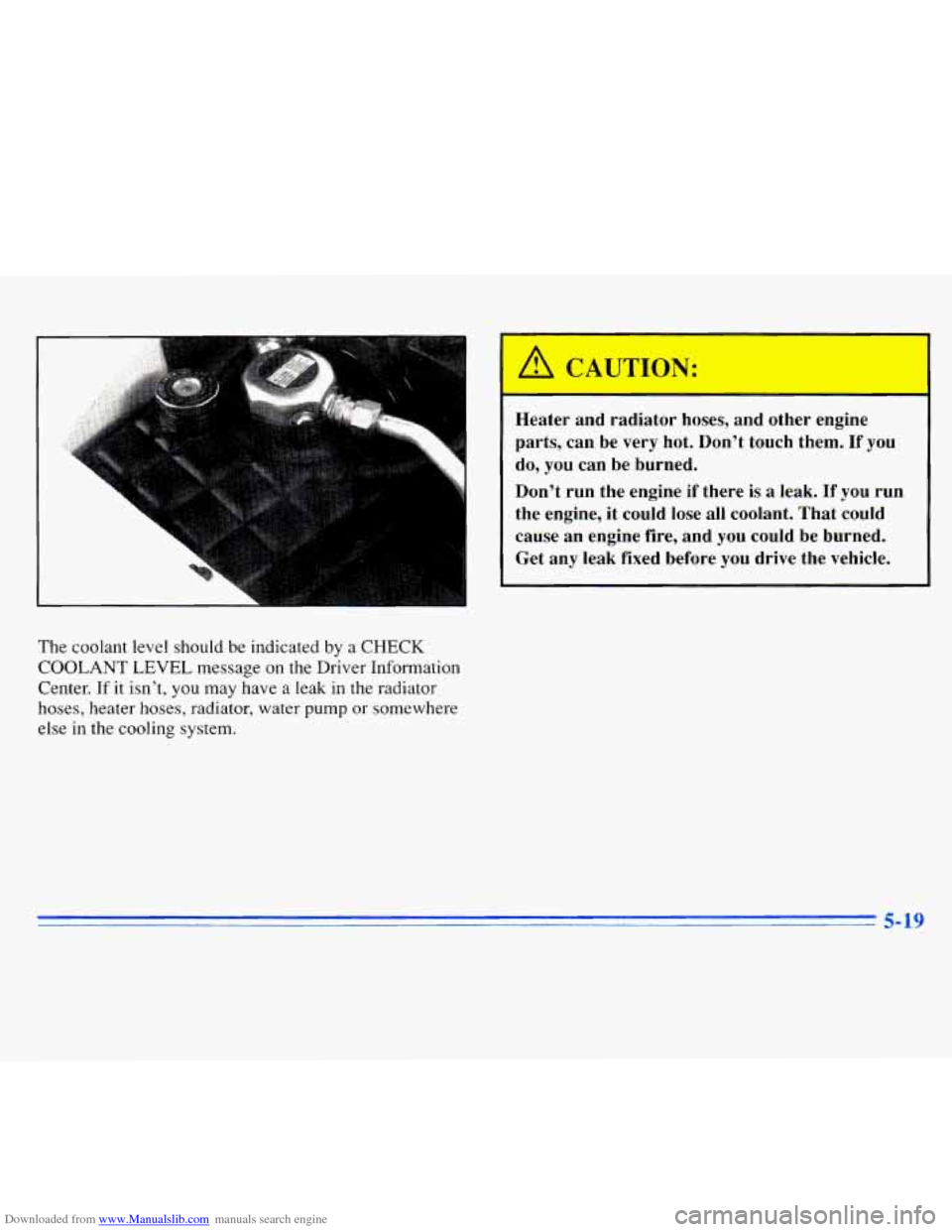
Downloaded from www.Manualslib.com manuals search engine The coolant level should be indicated by a CHECK
COOLANT LEVEL message on the Driver Information
Center. If
it isn’t, you may have a leak in the radiator
hoses, heater hoses, radiator, water
pump or somewhere
else
in the cooling system,
A CAUTION:
Heater and radiator hoses,
parts, can be very hot. Don’t touch them.
If you
do, you can be burned.
Don’t run the engine if there is
a leak. If you run
the engine,
it could lose all coolant. That could
cause an engine fire, and you could be burned.
Get
any leak fixed before you drive the vehicle.
5-19
Page 241 of 354
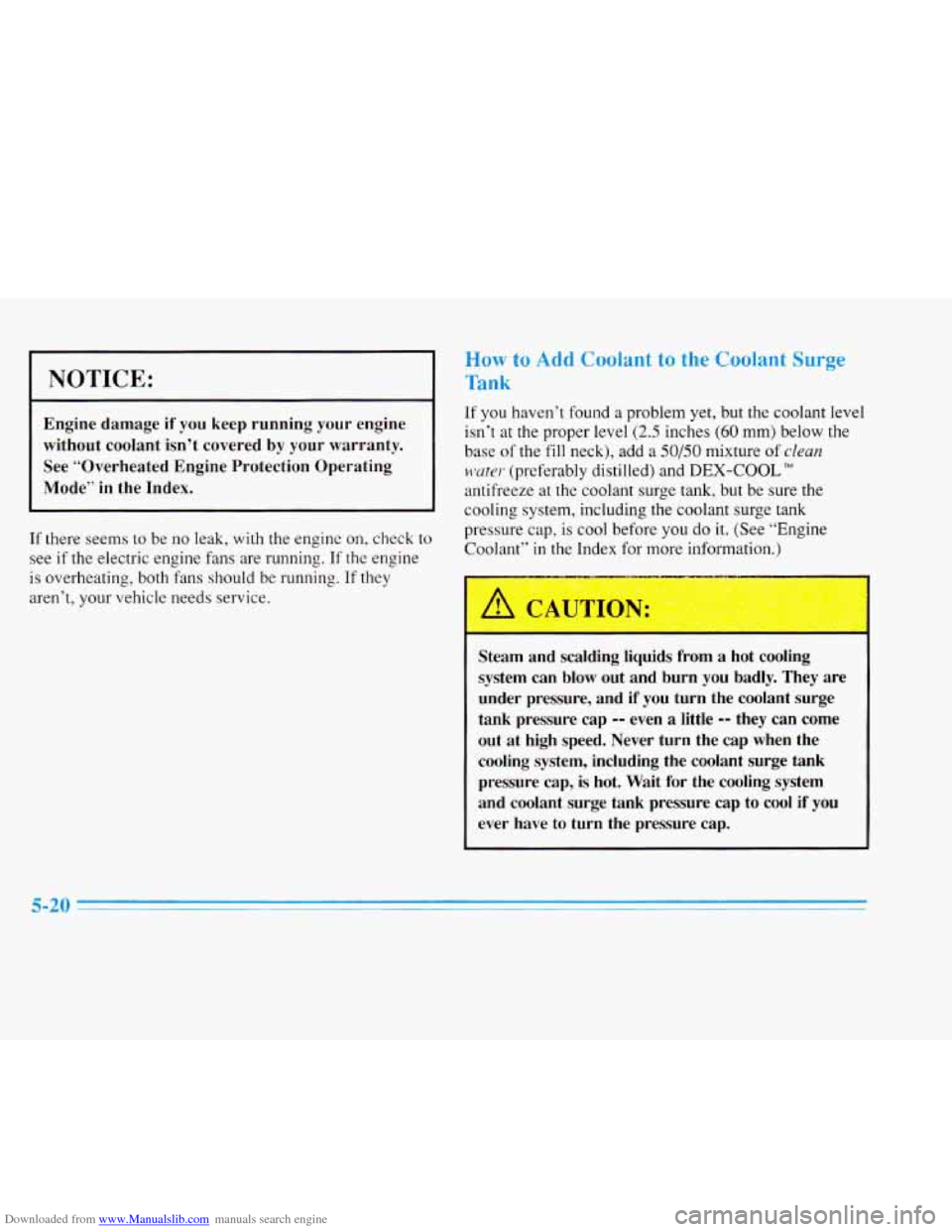
Downloaded from www.Manualslib.com manuals search engine NOTICE:
Engine damage if you keep running your engine
without coolant isn’t covered by
your warranty.
See “Overheated Engine Protection Operating
Mode” in the Index.
If there seem to be no leak, with the engine on, check to
see if the electric engine fans are running. If the engine
is overheating, both fans should be running. If they
aren’t, your vehicle needs service.
How to Add Coolant to the Coolant Surge
Tank
If you haven’t found a problem yet, but the coolant level
isn’t at the proper level
(2.5 inches (60 mm) below the
base
of the fill neck), add a 50/50 mixture of cleun
water (preferably distilled) and DEX-COOL TM
antifreeze at the coolant surge tank, but be sure the
cooling system, including the coolant surge tank
pressure cap, is cool before
you do it. (See “Engine
Coolant’’ in the Index for more information.)
Steam and scalding liquids from a hot cooling
system can blow out and burn you badly. They are
under pressure, and if you turn the coolant surge
tank pressure cap
-- even a little -- they can come
out at high speed. Never turn the cap when the
cooling system, including the coolant surge tank
pressure cap,
is hot. Wait for the cooling system
and coolant surge tank pressure cap to
cool if you
ever have to turn the pressure cap.
Page 245 of 354
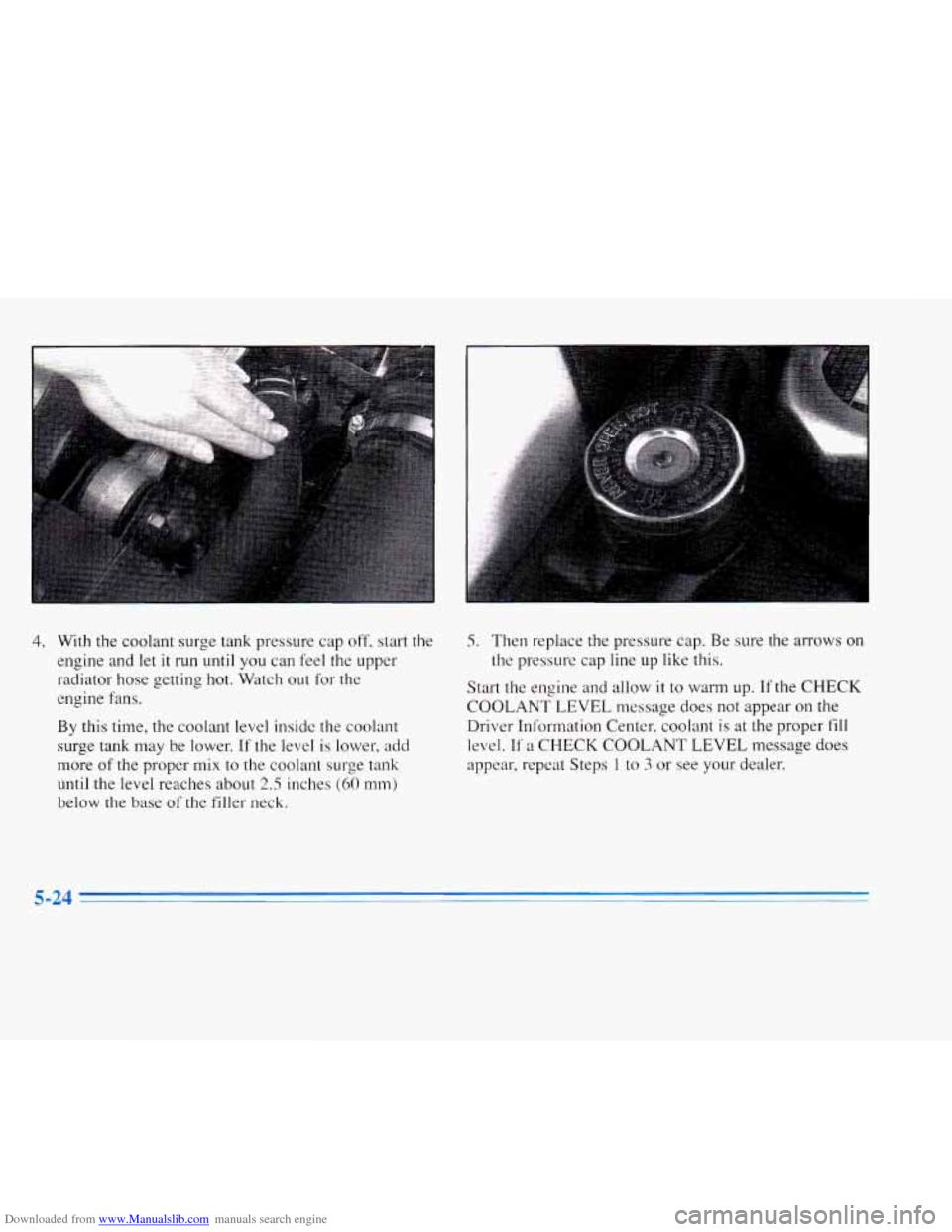
Downloaded from www.Manualslib.com manuals search engine 4. With the coolant surge tank pressure cap oft', start the 5. Then replace the pressure cap. Be sure the arrows on
engine and let it run until you can feel
the upper the pressure cap line up like this.
radiator hose getting hot. Watch out for the
engine fans.
By this time, the coolant level inside the coolant Driver Information Center, coolant
is at the proper fill
surge tank may be lower.
If the level is lower, add level. If a CHECK COOLANT LEVEL message does
more
of the proper mix to the coolant surge tank appear, repcat Steps 1 to 3 or see your dealer.
until the level reaches about
2.5 inches (60 mm)
below the base
of the filler neck. Start
the engine and allow
it to warm up. If the CHECK
COOLANT LEVEL message does not appear on the
Page 280 of 354

Downloaded from www.Manualslib.com manuals search engine Checking Coolant
The surge tank is located next to the engine block on the
passenger’s side of the engine.
The cooling system when hot is under
a lot of pressure.
If the CHECK COOLANT LEVEL message appears on
the
DIC, you will need to add coolant.
A CAUTION:
I
I
lhrning the surge tank pressure cap when the
engine and radiator are hot can allow steam and
scalding liquids
to blow out and burn you badly.
Never turn the surge tank pressure cap
-- even a
little
-- when the engine and radiator are hot.
When your engine is cold, the coolant level should be at
the full cold mark, which is
2.5 inches (60 mm) below
the base
of the fill neck. Use a flashlight as necessary to
see into the tank..
6-21